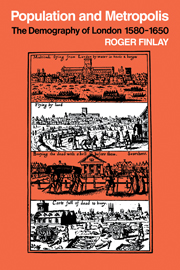Book contents
- Frontmatter
- Contents
- List of tables
- List of figures
- Preface
- 1 Introduction: The magnet of the metropolis
- 2 The accuracy of the London parish registers
- 3 The general growth of population in London
- 4 London social structure in 1638
- 5 The measurement of mortality rates
- 6 The effect of plague on mortality experience
- 7 Marriage and fertility
- 8 Population and metropolis
- Appendix 1 The London bills of mortality
- Appendix 2 Baptisms and burials in sample London parishes
- Appendix 3 Details from the 1638 listing and administrative divisions of London
- Appendix 4 London population in 1631 and houses in 1638 by wards
- References
- Index
4 - London social structure in 1638
Published online by Cambridge University Press: 06 July 2010
- Frontmatter
- Contents
- List of tables
- List of figures
- Preface
- 1 Introduction: The magnet of the metropolis
- 2 The accuracy of the London parish registers
- 3 The general growth of population in London
- 4 London social structure in 1638
- 5 The measurement of mortality rates
- 6 The effect of plague on mortality experience
- 7 Marriage and fertility
- 8 Population and metropolis
- Appendix 1 The London bills of mortality
- Appendix 2 Baptisms and burials in sample London parishes
- Appendix 3 Details from the 1638 listing and administrative divisions of London
- Appendix 4 London population in 1631 and houses in 1638 by wards
- References
- Index
Summary
So far, I have concentrated on the examination of population trends in London as a whole. However, it is well known that in early modern times there were wide variations in demographic experience between places which were situated near each other. In the very long term, one of the more important themes in population history has been the gradual elimination of these local differences, so that by modern times the range of variation in population trends within a country, city or area and between city and countryside has become very much smaller than at the beginning of the parish register period. The magnitude of local demographic variations depends of course on the size of the area under consideration. The smaller the area and population being observed, the sharper the contrasts. The demographic performance of any area must therefore be a weighted average of the many different local variations within its boundaries. These comments apply equally well to the study of a city and of the countryside, especially in a city like London which was as large, or even larger, than important country regions. Just as there were marked contrasts between the demographic experience of urban and rural areas in the early modern world, so there were equally wide variations within each sector.
We have seen that the most accurate way of obtaining reliable demographic rates from parish registers is by the technique of family reconstitution, and that the success of this method depends on the study of relatively small areas in depth.
- Type
- Chapter
- Information
- Population and MetropolisThe Demography of London 1580–1650, pp. 70 - 82Publisher: Cambridge University PressPrint publication year: 1981



